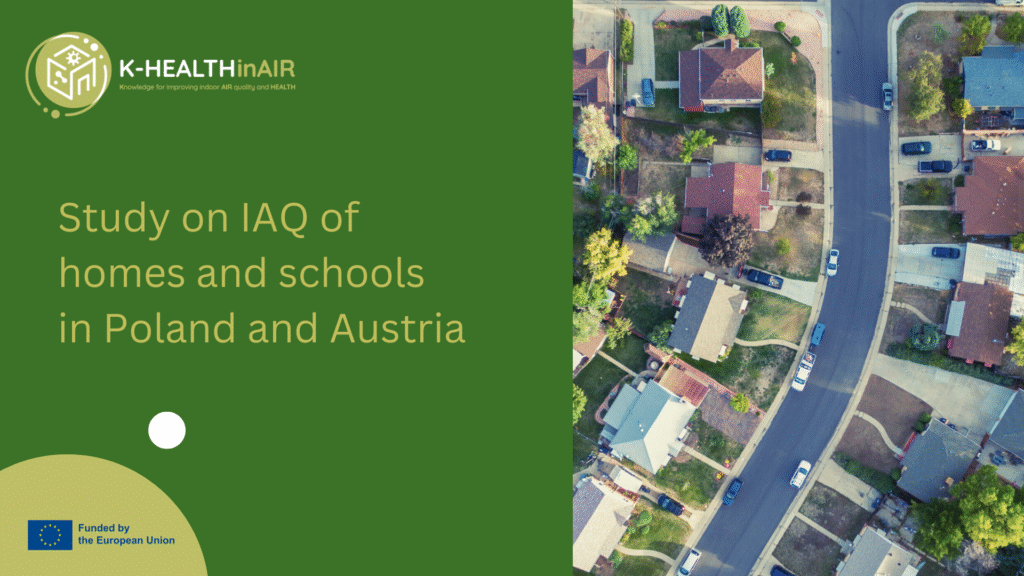
Indoor air quality (IAQ) has a profound impact on health and well-being, yet it remains an under-addressed issue compared to outdoor pollution. Within the European Union–funded K-HEALTHinAIR project, Pilot Study #5 is investigating IAQ in two key everyday environments: homes and schools.
This pilot is coordinated by the NOFER Institute of Occupational Medicine (Poland), with field operations carried out by the Warsaw University of Technology and the Medical University of Vienna.
The study’s main objective is to better understand how indoor environments affect human health, and it also aims to identify pollution sources, evaluate health impacts, and develop recommendations for creating healthier living and learning spaces across Europe.
Pilot Study #5 is being conducted across several locations in Poland—including Warsaw and Lodz—and in Austria, spread across the country. Researchers are working across two types of environments: private homes and educational institutions.
In residential settings, the study analyses how different heating and cooking systems—from traditional solid fuel stoves to modern electric and renewable energy solutions—affect IAQ. Special attention is given to newly built homes, as they may emit higher levels of volatile organic compounds (VOCs) from fresh construction materials.
Meanwhile, in schools, researchers are monitoring IAQ to understand the impact of factors like building ventilation, occupancy, and external environmental conditions.
The participants include residents of 37 homes in Poland and 28 in Austria, along with students and teachers from 22 Polish and 3 Austrian schools, offering a wide sample of building types, ages, and heating systems.
Indoor air is continuously monitored for key parameters including temperature, relative humidity, carbon dioxide (CO₂), particulate matter (PM2.5 and PM10), and total volatile organic compounds (tVOCs) using sensors. Radon is also regularly measured, though not via continuous sensor-based monitoring. Continuous monitoring is complemented by seasonal manual sampling campaigns targeting specific pollutants, such as PAHs (Polycyclic Aromatic Hydrocarbons), VOCs, and microbial contaminants.
Beyond air quality indicators, the study also gathers health data through participant questionnaires addressing respiratory symptoms, mental health, and quality of life. Additionally, urine samples are collected from residents to measure exposure to PAHs, further linking environmental data to potential health impacts.
The monitoring strategy in the K-HEALTHinAIR project is adapted to the specific protocols and priorities of each country, with notable methodological differences between Poland and Austria in both homes and schools.
In Poland:
In Austria:
In both countries, health symptoms related to sick building syndrome, mental health, and quality of life are evaluated using standardized questionnaires administered in both home and school scenarios. Poland and Austria utilise the same questionnaire to ensure consistency and comparability across study sites.
The pilot study incorporates two additional research components:
In 2025, an intervention study was introduced to test the effectiveness of air filtration devices in real-world home settings. Participants used air purifiers over a controlled two-week period—first without the filter running and then with it activated—to evaluate changes in particle concentrations and gather user feedback on practicality and noise. The participants additionally completed a checklist of activities over the periods to identify peak values.
Preliminary findings from the Poland and Austria study sites already offer valuable insights:
In Austrian schools, the study observed that indoor particulate matter (PM) levels closely correlate with outdoor PM concentrations, suggesting significant infiltration from external sources. Conversely, total volatile organic compounds (TVOCs) exhibited a positive correlation with indoor carbon dioxide (CO₂) levels, indicating that human occupancy and activities are primary contributors to VOC concentrations. These findings underscore the dual influence of outdoor air quality and indoor human activities on IAQ in educational settings.
The Polish segment of the study focused on three groups of VOCs: aldehydes, alcohol-based VOCs, and non-alcohol VOCs. Formaldehyde levels remained below national safety thresholds across all samples, with no significant differences between schools in high-traffic areas and those in quieter locations, suggesting indoor sources - such as furniture, carpets, and floorboards - are the main contributors. Acetaldehyde and acetone were also prevalent, likely emanating from building materials and human respiration, respectively. Seasonal variations were noted, with higher aldehyde concentrations in winter, potentially due to reduced ventilation. Ethanol, commonly found in hand sanitizers and cleaning products, was the most frequently detected alcohol-based VOC. Non-alcohol VOCs, including aliphatic and aromatic hydrocarbons, showed elevated levels during the heating season, attributed to decreased ventilation and accumulation of indoor emissions.
Measurements across 222 schools highlighted concerning levels of radon, particularly in geologically risky areas such as the Sudety Mountains. Several schools exceeded the EU’s reference level of 300 Bq/m³, prompting calls for enhanced building ventilation and radon mitigation measures. The study’s focus on schools aligns with national legislation, ensuring consistent monitoring and protection for children and staff.
Higher concentrations of polycyclic aromatic hydrocarbons (PAHs), notably carcinogenic compounds like benzo(a)pyrene, were recorded during winter months, correlating with increased solid fuel use for heating. Interestingly, some homes exhibited elevated PAH levels during summer, indicating possible unidentified internal sources. These findings emphasize the need for detailed source tracking and targeted interventions to mitigate exposure.
Bacterial loads were primarily linked to human activity, whereas fungal spore concentrations mirrored outdoor trends. Opening windows effectively reduced bacterial contamination but led to increased fungal exposure during summer months.
Analysis of indoor pollution determinants in schools across both Poland and Austria revealed that PM2.5 concentrations varied notably depending on the surrounding environment, particularly near residential areas using solid fuels. CO₂ levels peaked during school hours, confirming the need for improved ventilation practices during occupancy. These results support stricter air quality management strategies for educational institutions.
The interim findings from K-HEALTHinAIR’s Pilot Study #5 confirm that indoor air pollution is a complex, dynamic issue shaped by seasonal factors, building characteristics, heating systems, and human behaviour.
To protect vulnerable groups such as children, seniors, and people with respiratory conditions, the study highlights the urgent need for:
The results so far underline the critical importance of designing healthier indoor spaces and show that proactive air quality management can significantly enhance health and well-being. Further research, ongoing until 2026, will continue refining these insights and guide evidence-based policy recommendations for the future.